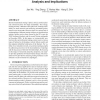Free Online Productivity Tools
i2Speak
i2Symbol
i2OCR
iTex2Img
iWeb2Print
iWeb2Shot
i2Type
iPdf2Split
iPdf2Merge
i2Bopomofo
i2Arabic
i2Style
i2Image
i2PDF
iLatex2Rtf
Sci2ools
CONEXT
2007
ACM
2007
ACM
Internet routing resilience to failures: analysis and implications
Internet interdomain routing is policy-driven, and thus physical connectivity does not imply reachability. On average, routing on today's Internet works quite well, ensuring reachability for most networks and achieving reasonable performance across most paths. However, there is a serious lack of understanding of Internet routing resilience to significant but realistic failures such as those caused by the 911 event, the 2003 Northeast blackout, and the recent Taiwan earthquake in December 2006. In this paper, we systematically analyze how the current Internet routing system reacts to various types of failures by developing a realistic failure model, and then pinpoint reliability bottlenecks of the Internet. For validity of our simulation results, we generate topology graphs by addressing concerns over the incompleteness of topology and the inaccuracy of inferred AS relationships. By focusing on the impact of structural and policy properties, our analysis provides guidelines for fu...
| Added | 14 Aug 2010 |
| Updated | 14 Aug 2010 |
| Type | Conference |
| Year | 2007 |
| Where | CONEXT |
| Authors | Jian Wu, Ying Zhang, Zhuoqing Morley Mao, Kang G. Shin |
Comments (0)

